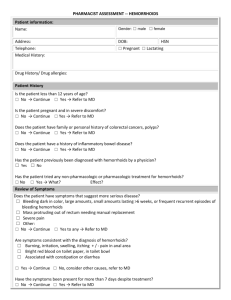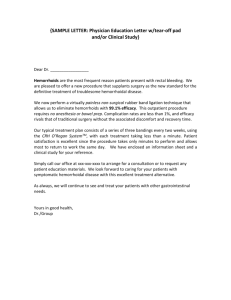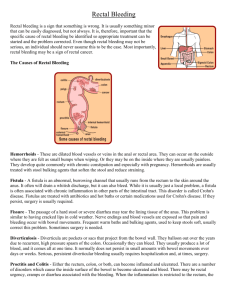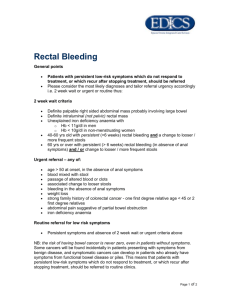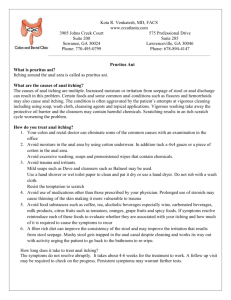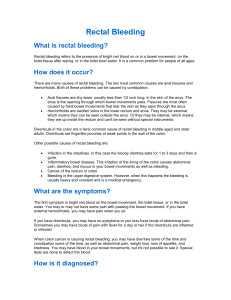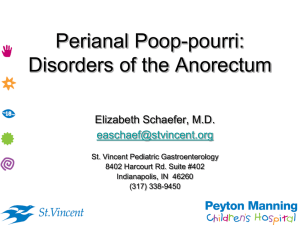Intestinal dispeptic syndrome
advertisement
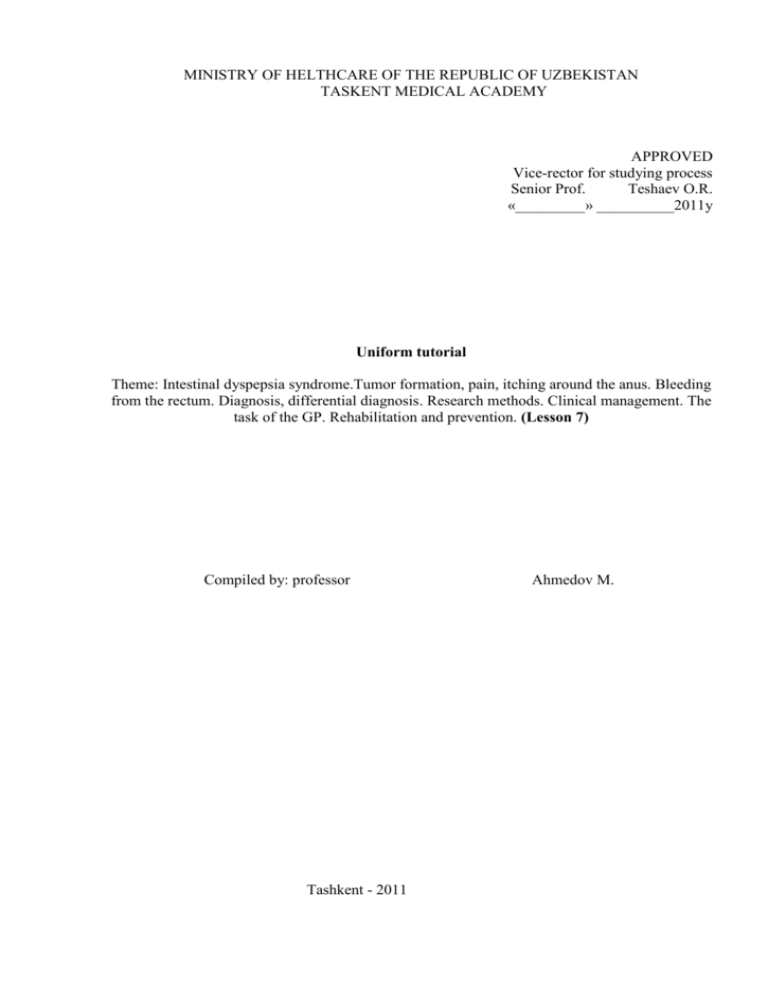
MINISTRY OF HELTHCARE OF THE REPUBLIC OF UZBEKISTAN TASKENT MEDICAL ACADEMY APPROVED Vice-rector for studying process Senior Prof. Teshaev O.R. «_________» __________2011y Uniform tutorial Theme: Intestinal dyspepsia syndrome.Tumor formation, pain, itching around the anus. Bleeding from the rectum. Diagnosis, differential diagnosis. Research methods. Clinical management. The task of the GP. Rehabilitation and prevention. (Lesson 7) Compiled by: professor Tashkent - 2011 Ahmedov M. 2 APPROVED On conference in department of surgical diseases for general practitioners Head of department___________________senior prof Teshaev O.R. Text of lecture accepted by CMC for GP of Tashkent Medical Academy Report №___________from____________2011 y Moderator senior professor Rustamova M.T. 3 Exercise: № 7 Subject: tumor formation, pain, itching of the anus. Bleeding from the rectum.Diagnosis, differential diagnosis. Research methods. Clinical management. The task of the SPM. Rehabilitation and prevention. 1. Venue activities and equipment: Hospital, training room, office surgery, dressing room, operating. Case patients, outpatients medical records, blood tests and urine tests, the results of instrumental studies, guidelines, training manual on practical exercises, case studies, test questions, algorithms, performance skills, scripts, interactive teaching methods, standard protocols, handouts from the Internet slaydoskop, slides, TV-vidio. 2. Duration of training - 327 minutes. 3. Session Purpose: 3.1. Learning Objectives: - Form the essence of the concept of tumor formation syndromes, pain, itching around the anus and rectal bleeding; Disease-master, whose main clinical symptoms of a tumor-like formation, pain and itching of the anus, rectal bleeding; - The skills of clinical examination of patients and be able to identify the main symptoms of the disease perianal area; - Create the ability to analyze data of laboratory and instrumental methods; - To form a provisional diagnosis and differential diagnosis; - Learn basic principles and tactics of treatment of patients; -Learn the tactics of GPs, principles of treatment and rehabilitation of patients who have tumor formation, pain and itching around the anus, rectal bleeding; 3.2 The student should know: • anatomy and physiology of the colon and rectum; • etiopathogenesis and clinic of the syndrome of "tumor formation, pain, itching around the anus. Bleeding from rectum " • conduct a survey of patients who have tumor formation, pain and itching around the anus, rectal bleeding • diagnosis and differential diagnosis; • indications for hospitalization; • the methods and scope of the survey; • formulate and justify a clinical diagnosis; • tactics of treatment of patients; • carry out preventive measures in individuals at risk for this disease; 3.3 The student should be able to: • Supervision of patients, professional inspection and inquiries; • palpation of the abdomen, the colon • finger rectal examination; • Conduct rectoscopy; • interpretation of laboratory data, radiological and instrumental studies; • if necessary, to provide emergency surgical care. • conduct regular check-up • sigmoidoscopy, sfinkterometry 4. Motivation. Syndrome "tumor formation, pain, itching of the anus. Bleeding from the rectum, "the widespread pathological condition in which the GP may often encounter in their practice, and thus should be carried out the correct approach to diagnosis and differential diagnosis. For example, the causes of bleeding from the rectum could be hemorrhoids, fissures, polyps, cancer of the rectum, ulcerative colitis, etc. Each of these abnormalities requires an individual approach to treatment. When choosing the wrong treatment or delayed diagnosis and the correct 4 determination of treatment strategies can lead to various complications. In order to prevent such errors and complications with the syndrome of "tumor formation, pain, itching of the anus.Bleeding from the rectum, "GPs should be able to diagnose, determine the timing of planned and emergency hospitalization of patients with these pathologies. 5. Interdisciplinary and inside disciplinary communication. Anatomy, regional anatomy pathological anatomy, pathophysiology, clinical pharmacology, gastroenterology, infectious disease, endocrinology, surgery, oncology, anaesthesiology and resuscitation. Colon - the distal digestive tubes, which starts from the ileocecal and ends outside of the anal canal opening. The total length of 1.75 - 2 m. In the colon, there are two main divisions - colon (length 1.5 - 1.75 m) and straight (length 15 -20 cm) intestine. For colon cancer is characterized by numerous protrusions haustrum that are not in the small intestine. Because there is a significantly increased absorptive haustrum and secreting mucosal surface of the colon, due to the severity of the circular muscle layer at the boundary of each haustrum is promotion of feces on the colon.Haustration loss, such as the inflammatory process leads to a gross violation of the motor and evacuation of the colon, resulting in pathological changes in the secretory and excretory functions of her. Throughout the colon in radiological and endoscopic study indicated physiological narrowing of the lumen. The clinical significance of the sphincters of the colon that under certain pathological conditions comes their spastic contraction, accompanied by severe pain. For all divisions of the colon is characterized by a well-defined network vneorgannyh arterial and venous anastomoses between the upstream and downstream branches.They form a parallel, or boundary, the vessel, which is located some distance from the mesenteric edge of the colon. Vessel boundary is a collection of links vascular arcade I order, which runs the "direct" the vessels taking part in the blood supply to the wall of the colon. Venous drainage is carried out in the portal vein and lymph – in around the colon nodes (20-30), arranged in two rows in the sigmoid mesentery. The rectum is the distal colon, located in the pelvic cavity and ending in the crotch.Transition area in the sigmoid colon is located directly below the cape a few of the sacrum and is called rektosigmoidnogo department. At this level of the sigmoid colon mesentery disappears, and the longitudinal muscle layer evenly distributed around the circumference of the rectum is it lacks three lines expressed the muscle (the shadow), typical of the overlying parts of the colon. There are two main sections of the rectum: a pelvic and perineal, the boundary between them is in the place of attachment of the muscle that lifts the anus. In the first (pelvic) section, in turn, secrete a small extent on the site - and the ampullar part has upper ampullar section - the widest and most long-haul portion of the rectum.Perineal section of the rectum is also called the anal canal, and 3 / 5 of total length of the colon accounts for the ampullar section, 1 / 5 – upper ampullar part and the same - in the anal canal. The rectum has several bends in the frontal and sagittal plane: it follows the course of the sacrum and coccyx. Most important in practical terms, such as rectoromanoscopy be two bending in the sagittal and a frontal plane. Anatomy of the rectum: 1.Seroz membrane (peritoneum), 2 mg of the rectum 3. The anal canal, anus sphincter 4.nutrenny 5. External sphincter anus 6. Anus 7. Anal comb 8. Anal column 9.Anal sinus 10. Muscle lifting the anus 11. Transverse fold of rectum 12. Mucosa, 13.Muscle membrane. The upper ampular part of the rectum is covered by peritoneum on three sides, the direction it gradually loses its peritoneal covering, and at the level of the sacral spinal IY peritoneum covered only the front surface of the intestine. At this level, the rectum is closely adherent to the surrounding organs, men - to the rear surface of the bladder, women - to the uterus. Thus, the lower portion of the rectum ampulla is located under the peritoneum. Outwards from the side 5 surfaces of the rectum, between them and the walls of the pelvis, there is deepening, where the ureters and the branches of the internal iliac vessels. On top of these deeper down loops of small intestine. Go to the front surface of the rectum in men vials vas deferens and seminal vesicles, and a few below - the rear surface of the prostate, in women - the rear wall of the vagina. Anal canal is a transition zone between the outer opening of the anus and rectum. Its length is 24 cm from the skin to the anorectal (dentate) line. The channel is covered by transitional epithelium, which contains sweat glands and hair follicles. This epithelium thins and ends near the dentate line. In the passive state of the anal canal lumen is closed by tonic contraction of its muscles (internal sphincter). In the anal canal circular fibers expressed particularly strong image of the internal anal sphincter, whose length is 3-4 cm and a thickness of 1 cm internal sphincter fibers (smooth muscle) are surrounded by a ring of the external sphincter (striated muscle). External sphincter is the most superficial of all the muscles of the perineum. It surrounds the distal segment of the rectum broad muscular ring, the height (width is 2.5 - 3 cm) External sphincter muscle is composed of three portions. Muscle fibers of the surface portion of cross anterior to the anus and attached to the skin surrounding the anus.The second, more deeply situated portion starts from the center of the tendon of the perineum. Muscle fibers of this portion covering the rectum from all sides and partially attached to the skin, in part to the periosteum covering the tailbone. The deepest portion of the third external sphincter, which consists of circular muscle fibers in the form of a cylinder cover internal sphincter of the rectum. From the top side surfaces between the external sphincter and rectum woven fibers of the three portions of the muscle that lifts the anus, which is almost circular covering the rectum. External sphincter is innervated by perineal anus sexual branches (pudendal) nerve stimulation in isolated which there is a reduction. Internal sphincter is innervated primarily by sympathetic nerve branches sex, which are postganglionic fibers originating from the sacral sympathetic ganglia. The internal sphincter exercises tonic closure anus. The closure of the anus is due to passive muscle contractions of the internal sphincter. External sphincter, innervated by motor nerves, that contracts will power. The interaction of these sphincters depends largely on the state of the nerve ganglia embedded in the wall of the rectum. Blood supply of the rectum by a single unpaired artery - the upper rectal and two guys - middle rectal (branches of internal iliac artery) and lower rectal (internal genital branch artery). The upper rectal artery is a continuation of inferior mesenteric artery - the main arterial vessel of the rectum. Venous drainage from the rectum by two venous systems - and the inferior vena portal vein. This forms three venous plexus - subcutaneous, submucosal, and podfastsialnoe. From 2 / 3 rectal venous blood flowing through the upper rectal veins in the lower mesenteric (portal vein), and from the bottom third - a system of inferior vena cava. Innervation of the rectum by the sympathetic and parasympathetic fibers. Perineal section of the rectum is innervated by the nerve sexually, which includes motor and sensory fibers. Outflow of lymph from the rectum is carried out in four main areas. Of the anal canal inguinal lymph flowing libov or in regional lymph nodes located under their own fascia of the rectum (Gerota nodes). From the upper rectal lymph enters the sacral lymph nodes along the upper rectal artery. Thus, lymph drainage - in the inguinal lymph nodes (lower parts of the rectum), the second - in upper rectal, and the third - in the sacral lymph nodes, and the fourth line - in the lower iliac arterial collectors. 6. The content of lesson 6.1.Theoretical part Diseases of the rectum and anal area occur in practice, a family doctor often enough. Bulk education anus can be divided into true and dropped out of the rectum. Last fall out during defecation, and then independently reduce a. These include hemorrhoids internal hemorrhoid at II and stage III, hypertrophied anal papillae, the polyps. May fall wall of the rectum. By the true 6 education anus include anal fringe, hemorrhoids with internal hemorrhoids and genital warts. Anal fringe usually occur after perianal hematoma resorption. Genital warts differentiated with extensive warts (signs of secondary syphilis). Many patients with suspected tumor in his, and their complaints should be taken carefully. Colon and rectal cancer should be suspected if the patient has a surround of education, as well as bleeding from the anus, even with concomitant hemorrhoids. Symptoms of anorectal disease: pain in the rectum, three-dimensional formation, discharge from the anus, bleeding, anal itching. Pain in the rectum usually occurs during defecation. Pain in the absence of surround formation observed in anal fissure, ulcerative proctitis rectalgia. Pain in the presence of the bulk of education observed in anal hematoma, strangulated internal hemorrhoids, paraproctitis and malignancy. Hemorrhoids - one of the most common human diseases. This term is found, starting with the works of Hippocrates, and in Greek means bleeding, reflecting only the most striking feature of the disease. With modern nosological position to hemorrhoids include all the various clinical manifestations of pathological changes of hemorrhoids (bleeding, prolapse of internal thrombosis and swelling of the external nodes, necrosis and purulent fusion of them, maceration, accompanied by itching, etc.) suffers from hemorrhoids for more than 10 % of the adult population, and its share of diseases of the rectum is about 40%. The most common cause of hemorrhoids - chronic constipation due to consumption of foods low in fiber. Hemorrhoids - this is not the usual pathological changes, and the cavernous veins of the rectum. Direct arterio-venous anastomoses cavernous rectal cells explain arterial bleeding from hemorrhoids. In most cases, formed only three major hemorrhoidal node - 3.7 and 11 hours on the dial (with the position of the body on the back). Classification and clinical picture. There are many classifications of hemorrhoids - by anatomical basis (the external and internal), the clinical course (acute and chronic), severity (four degrees). External hemorrhoids. Hemorrhoids External hemorrhoids are located at the dentate line of the distal anus and are covered by squamous epithelium. External hemorrhoids may thrombose or overflow blood clots. Internal hemorrhoids. Hemorrhoids internal hemorrhoid at located medially (proximal) from the dentate line and covered by transitional and columnar epithelium. First-degree hemorrhoids are found swollen and bleeding hemorrhoids. Seconddegree hemorrhoids hemorrhoids and reduce a drop on their own. Third-degree hemorrhoids Hemorrhoids can be precipitated by hand straighten. Finally, the fourth-degree hemorrhoids hemorrhoids can not straighten. Acute hemorrhoids. Synonyms - strangulated hemorrhoids, acute hemorrhoidal thrombosis. Pathogenetic processes that underlie the thrombosis hemorrhoids involve a violation of the microcirculation, expressed in cochlear dysfunction of the arteries and veins which discharge, which ultimately leads to a slowing of blood flow, a dramatic expansion of the cavernous veins and damage the endothelium. In the clinic of acute hemorrhoids can distinguish four degrees of severity. I degree. Small subcutaneous, slightly painful education with mild hyperemia of the skin over them. Complaints of burning, itching, worse after stool, and with an abundant use of alcohol and spicy food. Grade II. Anal region sharply painful, hyperemic. A digital examination is almost impossible and not necessary. No instrumental studies. No straightening fallen and infringed nodes. The only thing necessary - to differentiate this condition from acute paraproctitis. In acute inflammatory reaction of hemorrhoids and diffuse hyperemia, takes all the anal skin ring, and when paraproctitis usually struck some wall and anal canal because finger study possible, and thus almost always possible to determine the wall of the anal canal concerned, where is the internal opening the abscess. In stage III of acute severity of hemorrhoid anus whole circle is sharply painful dense 7 infiltrate. Ushemlennye purplish-blue hemorrhoids are tense and not vpravlyayutsya.U men often dysuria, up to anuria. In these patients, there is a sharp constant pain, not certainly worse during or after stool. The general condition for this is usually mild, fever may not be in a blood test is almost unchanged, indicating that still the local nature of the process. If such patients do not receive intensive therapeutic measures, may develop gangrene or septic process (IY stage) with a melting tissues of the perineum, up to sepsis. Bleeding is often the only symptom of the disease. Other symptoms - loss of nodes, mucous discharge, irritation and itching, constipation, and pain. Hemorrhoids must be distinguished from anal fissures, polyps, paraproctitis, rectalgia, melanoma, villous tumors, rectal cancer, foreign bodies. It must be remembered about the possibility of secondary piles in liver cirrhosis, certain diseases of the cardiovascular system of tumors and in violation of venous outflow.Clinically, secondary hemorrhoids may be accompanied by dilatation of the rectum, pelvis, anterior abdominal wall, lower extremities. Acute anal fissure, as well as rectalgia often occurs as a complication of chronic hemorrhoids. Common symptoms of acute hemorrhoids, and these diseases is a pain. If the anal fissure and thrombosis, pain is associated with the act of defecation, but it may take a crack is much longer, and the patients it clearly localize. It is essential to study finger at rectalgia, coccygodynia, diseases of long duration, with severe pain not related to the act of defecation, without any external and internal displays. A digital rectal examination to determine the health and mucosal pain with pressure on the tailbone, a pronounced spasm of the levator muscles of the anal sphincter and. Acute paraproctitis, the occurrence of which is not associated with hemorrhoids, usually located at some distance from the anus. The skin lesion focus in hyperemic, tense and painful. If you have hemorrhoids, they are in the process is not involved.Defecation painless, was not affected. Chronic hemorrhoids. This refers to the classic syndrome of hemorrhoidal: Pain in the anus during and after defecation, minor bleeding intermettiruyuschie also associated with a chair, and loss of internal nodes. It is often associated with anal itching or burning sensation or moisture in the perineum, the perianal skin hypersensitivity, etc. Discharge of blood from the rectum, associated with hemorrhoids, is a classic symptom of this disease. It is usually a pretty long time and often stop altogether after a temporary or persistent medical treatment or elective surgery. Complication is a copious, profuse bleeding, which quickly lead to anemia with a hemoglobin drop, when you need urgent action. By proctorrhagia symptom should be taken seriously. If it occurs in older people with severe disorders of the cardiovascular and pulmonary systems, especially in hypertension and heart failure, the question of surgical treatment need to decide carefully, carefully defining the indications and contraindications. If the copious blood from the rectum is not connected with the chair, observed in "false desires", and the blood is darker, it is necessary to show maximum onkoostorozhennosti, be sure and thoroughly not only the finger study, but examination with a speculum, anoscope, proctoscope and complete the survey irrigoscopy. Treatment. There are four basic methods of hemorrhoid treatment: sclerotherapy, rubber rings doping sites, cryotherapy, and hemorrhoidectomy. The best remedy for hemorrhoids prevention. You should avoid constipation, eat foods rich in fiber: fresh fruits and vegetables, whole grains, bran. Patients should try to defecation lasted no more than a few minutes. Laxatives are not recommended. Anal itching. A pathological condition characterized by persistent itching of the anus occurs in practice, quite often, although specific studies the proportion of anal itching in the structure of proctological diseases was conducted. Anal itching should be clearly divided into primary (synonyms: true, cryptogenic, idiopathic, neurogenic, essential) and secondary, often accompanies as a primary symptom of diseases such as hemorrhoids, anal fissure, helminth infestation, proctosigmoiditis, lack of sphincter anus, constipation, inflammation of the genitals, exposure to harmful endo-and exogenous substances and factors, fungal skin and sacrococcygeal 8 region. Anal itching may be an early sign of latent diabetes. Itching is worse at night and with heavy sweating - in hot weather, emotional and physical stress. Diagnosis. The first thing to check: 1) whether the itching associated with defecation, 2) whether increased itching after taking alcohol, spicy foods or Salen: the presence of this feature indicates the presence of proctosigmoiditis 3) whether the patient at home or on the production of harmful effects - chemicals, radiation, work in conditions of high temperature, etc. 4) whether there is close contact with pets (helminthic invasion), 5) the presence of the patient or his relatives of diabetes, fungal infections, constipation, diarrhea. Anal fissure - a fairly frequent proctological disease, a separate nosological form.Anatomic substrate of anal fissure is usually sharply painful ulcer on the border of the longitudinal transition in the skin lining the anal canal. It is necessary to distinguish between acute and chronic anal fissure. Development of anal fissures help constipation and tenesmus. Anal fissure is manifested by pain during bowel movements and prolonged spasm of the sphincter of the anus. The pain is excruciating and lasts for hours and irradiruet on the back of the legs. There is bleeding. They are usually small - in the form of spots of red blood on toilet paper. The typical triad of clinical symptoms of anal fissure - a pain, spasm of the sphincter and rectal bleeding during bowel movements. Survey: when viewed from anal fissure is an ulcer as an oval, located on the midline (for 6 or 12 hours). When multiple cracks should be suspected Crohn's disease. With long-term existence of the cracks in its inner edge formed a guard mound, represented by scar tissue, there are fistulas, stenosis develops the anus. Treatment: prevention of constipation, in particular the appointment of foods rich in fiber, can lead to complete recovery. Apply stretching the sphincter anus - under general anesthesia. With recurrent fractures and stenosis anus effective surgical treatment. Anococcygeal pain - coccygodynia and in the anal canal and rectum - rectalgia practice can be combined under the name "anakopchikovy pain." We should also consider the presence of traumatic coccygodynia obvious bone pathology in the sacrum - coccyx vertebrae. In the symptom syndrome leading symptom - pain, often sharp and short, rarely dull and persistent, not associated with the act of defecation, irradiated the perineum, buttocks and thighs. In this case, the pain does not appear as a symptom, a diagnosis, for a purely functional in nature, they are not caused by any organic lesions of the rectum, sacrum, or tailbone, genitalia in female urinary tract. In adults, mostly middle-aged men. The attacks often occur at night disturbs sleep. The reasons described pain is still not fully understood. Presumably, here plays the role of pathology of the nervous system sacrococcygeal plexus, etc. Examination of the patient with pain anokopchikovym includes finger rectal examination, radiographs rectoscopy sacrococcygeal spine, sfinkterometriyu, ballaonografiyu, seeding, fecal flora, scatological study. With appropriate complaints mandatory consultation urologist, gynecologist, neurologist, trauma. Treatment. First, you need to treat all of the identified related, especially proctological disease. But even if we found out etiological factors of pain, in addition to etiotropic treatment focuses doctor should give it pain therapy Bleeding from the rectum. Amount of bleeding can be different. The causes of bleeding can be anal fissure, haemorrhoids, single ulcer of the rectum, colon cancer, ulcerative colitis, polyps and polyposis, colon diverticula, colon cancer, colon angiodysplasia etc. The color of blood (red, black, black) nature of the bleeding (drop of blood on the strip surface feces, blood, mixed with feces, massive hemorrhage) helps to determine the source of bleeding. Bleeding hemorrhoids occur, usually from a small hemorrhoid and is characterized by the release of red blood. Isolation of blood with mucus observed in colorectal cancer proctitis. When bleeding from the rectum clarify all associated symptoms: pain, diarrhea, constipation, the presence of space-occupying 9 lesions, false desires, feelings of incomplete emptying. Survey of bleeding from the rectum in addition to measuring overall inspection includes anal area, rectal examination, colonoscopy, etc. For this class applies the following new educational technology: Students in the form of lots selected issues and prepare for 3 minutes, then everyone is responsible for their selected question, if necessary, complementary, or response is complemented by a teacher. Control questions: 1. The concept of hemorrhoids. 2. Factors of development of hemorrhoids. 3. Clinical characteristics of hemorrhoids 4. Methods of diagnosis of the syndrome of "tumor formation, pain, itching around the anus. Bleeding from the rectum. " 5. Complications of hemorrhoids. The answers to these questions: 1. Hemorrhoids - in Greek means bleeding. Violation of blood outflow from the cavernous venules of cells, which are located in the rectal wall, which wall is damaged cavernous bodies is bleeding. 2. Mechanical factors (constipation), inactive lifestyle, pregnancy, alcohol, spicy food, the infectious factor in cryptogenic infection, an allergic factor. 3. sensation in the anus easy itching, difficulty during defecation, bleeding, loss of nodes. When inflammation sites - increasing them, feeling strong, throbbing pain. 4. Inspection of the perianal area, digital research, rectoscopy. 5. Bleeding, thrombosis node loss. Teacher offers to disassemble management of patients with the syndrome of "tumor formation, pain, itching around the anus. Bleeding from the rectum. " The teacher divides the group into 2 subgroups, the rate of 1, 2. Drawn by lot by the task 1. "Clinical supervision of patients with the syndrome of" tumor formation, pain, itching around the anus. Bleeding from the rectum. " Then given time to prepare for writing answers in workbooks. Then read the answer, one participant subgroups. At this time, the rival group, together with the teacher are expert. Briefing - 3 min, the division of 2 minutes preparation time - 10 minutes, the performance of groups of 10 min (30 min). Card number 1. Clinical supervision of patients with diseases of the rectum. Clinical examination of the patient: 1) Pain in the anal area. 2) Isolation of blood during defecation. 3) Itching in the anal and perianal 4) Pale skin color - a sign of anemia Collect history: • The cause of the disease • duration of illness • received treatment, the types of drugs • the effect of treatment • the frequency of exacerbations Laboratory studies: • full blood and urine Conducting research methods: • Inspection of the perianal and anal area • Definition of skin-anal reflex • A digital study • Sfinkterometriya 10 • rectoscopy The tactics of a doctor depends on the shape and form of the disease complications. - In the presence of enlarged hemorrhoids, without any complications given preventive recommendations. - In the presence of complications of hemorrhoids - bleeding, thrombosis, loss of sending patients to a specialized agency. - Acute anal fissure appoint conservative treatment. - For chronic anal fissure with complications - pektenoz, education "watchdog tubercle" strong anal itching, difficult defecation send patients to a specialized agency. Interactive game "question ball" Write questions about the little pieces of paper and stick on the ball with a ribbon molding so that it is possible to read the questions completely and remove the following response. Throws the ball to one of the students. The student received the ball detaches one of the questions and answers the question written on a piece of paper. If the answer is correct the game continues and the student who answered the question, throws the ball to another student. Thus, the game continues until you have answers to all questions. Questions and answers: 1. Etiological factors of hemorrhoids? - Congenital insufficiency of the venous system anorectal region, the mechanical theory, endogenous and exogenous intoxication, infection, neurovascular. 2. Stage of deposition of hemorrhoids? - There are three stages of loss: 1-stage - nodes drop out during defecation and independently reduce a 2-step - to reduce a drop-down units, 3-phase nodes fall at the slightest exertion. 3. Extent of thrombosis hemorrhoids? - 1-degree. A small increase in units, easy flushing of the skin, 2-stepeng. Edema and congestion, severe pain. 3 - a sharp painful tumor formation in the anus, bluish-purple visible internal components fell, with areas of necrosis. 4. The causes of anal fissure? - Constipation, diarrhea, injury, foreign bodies, colitis, enterocolitis, hemorrhoids, etc. 5. Clinical symptoms of anal fissure? - Itching and burning sensation in the anus, tonic spasms anus, extreme pain during bowel movements, sometimes associated dysuria, intestinal colic, dysmenorrhea, angina. 6. The main methods of diagnosing the syndrome of "pain and swelling of the anal region?" - Visual inspection of the perianal area, digital rectal examination, sfinkterometriya, rectoscopy. 6. What are the surgical interventions for the treatment of chronic anal fissures? Open or closed lateral internal sphincterotomy, excision of the crack (the so-called ultserektomiya), excision of the crack and YV or any other kind of anoplasty or stretching the anal canal. 6.2.Analytical part. Situational problem. Enrolled 35 patients with complaints of pain in the anus, worse after defecation, presence of structures on the anal area. History of sick for three days. OBJECTIVE: general condition is satisfactory. When viewed in the anus indicated the formation of size 3x2 cm, bluish color, plotnoelasticheskoy consistency, painful on palpation. A digital rectal examination is not possible to carry out the strong pain. Questions: 1 Your first diagnosis 2 Which survey should be carried out? 3 Differential diagnosis 4. Tactics GPs № answers Max.ball Full answer Unsatisfactor y answer 11 1 2 3 4 The patient has an acute thrombosis of hemorrhoids Necessary to carry out rectal finger examination The differential diagnosis should be conducted acute paraproctitis, genital warts,epithelial coccygeal festering course and teratomatous cyst. The patient was shown a course of antiinflammatory therapy with subsequentoperations 5 5 0 5 5 0 5 5 0 5 5 0 Situational problem. Received 40 patient complained of severe pain in the anus, which appear after defecation, presence of blood in the act of defecation. Anamnesis: ill for three years. Objective: the overall condition of the patient is satisfactory. On examination of the anus at the back of the anal canal is a flaw size of 1.5 x0, 5 cmkalleznymi edges. questions: 1.Vash diagnosis 2.Plan survey 3 Differential diagnosis 4. Tactics treatment № 1 2 3 4 answers Max.ball The patient has a chronic anal fissure with back pain Necessary to carry out rectal finger examination under local anesthesia andsigmoidoscopy The differential diagnosis should be conducted acute paraproctitis, genital warts,epithelial coccygeal festering course and teratomatous cyst. The patient showed rapid treatment excision of anal fissure with measured backsphincterotomy. Full answer Unsatisfactor y answer 0 5 5 5 5 0 5 5 0 5 5 0 6.3. Practical part. Determination of the symptoms of anorectal disease № steps 1 2 3 4 5 Laying the patient Bozeman's position or on an examination table. Careful examination of the anus Finger research proyamoy intestine Determining the tone of the sphincter (sfinkterometriya) Definitions of state adrectal tissue and lymph nodes in her Not Fully implem fulfilled (0 poi ented correctl nts) y (10 points) 0 10 0 0 0 0 10 10 10 15 12 6 7 8 Rectoromanoscopy Anoscopy Colonoscopy In all: 0 0 0 15 15 15 100 Sygmoidoscopy Indications: Disorders of the colon and intestines, various inflammatory diseases and tumors of the colon and rectum, paraproctium. Required tools: proctoscope, transformer, glycerin or petrolatum. Position of the patient Bozeman. Student assignment: Explain indications, the necessary tools, training methods andtechniques of production sigmoidoscopy. Tell semiotics of disease and the possibility of additional research. Information Teachers: Assess the knowledge and skills of students through the stepsseparately. № steps 1 Prepare the patient siphon enema or testimony fortrans before the survey. Lubricate rectoromanoscope glycerine or petroleum jelly. 0 10 End of the tube with an 0 10 olive obturator carried through the anal canal to a depth of 4-5 cm and obturator removed. Promotion tube to a depth of 10 - 12 cm under the control 0 10 of the eye. When collapsed the walls of the intestine, with a 0 10 closed end of the peripheral ballooninflate tubosa intestine and gradually pr omote proctoscope to the end. You should not force the tube to promote, if it rests on 0 10 the mucus - may damage thelatter. The physician must see gut lumen Mucosa of the colon in catarrhal proctosigmoiditis dark red, long-term, 0 swollen,covered 10 with slime; When purulent catarrhal proctosigmoiditis are focal accumulations of pus in the mucus; In hemorrhagic proctosigmoiditis diffuse redness with hemorrhage in tolschu in the lumen of slime and blood, contact bleeding. Ulcerative proctosigmoiditis detected ulcers with irregular edges and saped fibrinouscoating on the bottom. When polypous0 10 ulcerative proktoigmoidite islets revealed normal mucosa betweenpolypoid formations. In the lumen of muco-purulent masses of blood. In Crohn's disease mucosal polypoid protrusion in the 0 form of "cobbles". During a sigmoidoscopy on the testimony of a 0 10 diagnostic biopsy is done, the printsmucosal smears tests. 100 2 3 4 5 6 7 8 9 10 7. Control methods used in class: • Oral response Not fulfilled (0 poin ts) 0 Fully implement ed correctly (10 points) 10 13 • Written response • Solving case studies • implementation of practical skills 8. Сriteria assessment of the current control № 1 % 96-100 mark Very well «5» 2 91-95 Very well «5» 3 86-94 Very well «5» 4 81-85% Well “4” Criteria In full view of a syndrome of tumor formation, pain, itching in the anal area, bleedingfrom the rectum. Classification of pathology, diagnosis, differential. Diagnosis andtreatment methods. The questions gives a correct and comprehensive answer. To think independently and draw conclusions. Selfsupervised patients and skillfullyapplies the practical skills. Interprets the data of clinical and instrumental studies.Independently, with knowledge of the facts involved in the choice of treatment. Actively involved in conducting intraktivnyh games. In solving the situational problems appliesunconventional approaches grounded i n the responses. In full view of a syndrome of tumor formation, pain and itching around the anus.Bleeding from the rectum. Classification of pathology, diagnosis, differential.Diagnosis and treatment methods. The questions gives a correct and comprehensiveanswer. To think independently and draw conclusions. Selfsupervised patients andskillfully applies the practical skills. Interprets the data of clinical and instrumental studies. Independently, with knowledge of the facts involved in the choice of treatment.Actively involved in conducting intraktivnyh games. In solving the situational problemsapplies unconventional approaches grounded i n the responses. When interpreting the data of laboratory tests made one mistake. The full syndrome has an idea about the volume of education, pain, itching of the anus.Classification of pathology, diagnosis, differential. Diagnosis and treatment methods.The questions gives a correct and comprehensive answer. To think independently anddraw conclusions. Selfsupervised patients and skillfully applies the practical skills.Interprets the data of clinical and instrumental studies. Independently, with knowledge of the facts involved in the choice of treatment. Actively involved in conductingintraktivnyh games. In solving the situational problems made 2.1 ko inaccuracies. A student in full view of a syndrome of tumor formation, pain, itching of the anus.Bleeding from the rectum. Classification, diagnosis, differential diagnosis andtreatments. The 14 5 76-80% Well “4” 6 71-75% 7 66-70% Well “4” Satisfactory “3” 8 61-65% 9 55-60% Satisfactory “3” Satisfactory “3” questions gives the correct answer. Selfsupervised patients andskillfully applies the practical skills. Interprets the data of clinical and instrumental studies, but not fully aware of the value of individual data. Knowingly involved in the choice of treatment. Actively involved in conducting intraktivnyh games. Case solvedthe problem correctly, but the rationale for not fully answer. Correct, but incomplete coverage of the issue of tumor formation syndrome, pain,itching of the anus, rectal bleeding, classification, diagnosis, differential diagnosis andtreatments. The questions gives the correct answer. To think independently.Selfsupervised patients and skillfully applies the practical skills. Interprets the data of clinical and instrumental studies, but not fully aware of the value of individual data.Knowingly involved in the choice of treatment. Actively involved in conductingintraktivnyh games. In solving the situational tasks and practical skills made 02.03inaccuracies. A student in full view of a syndrome of tumor formation, pain and itching of the perianal region. Bleeding from the rectum. Know the classification, diagnosis, differential.Diagnosis and treatment methods. The questions gives the correct answer. To think independently and draw conclusions. Selfsupervised patients and skillfully applies thepractical skills. Independently, with knowledge of the facts involved in the choice oftreatment tactics, but admits mistakes. In carrying out the practical skills makes a grave error. Situational problems decides not to complete. The student is responsible for half of the questions, but is aware of the syndrome,tumor formation, pain, itching around the anus. Bleeding from the rectum. Not fully aware of the classification, diagnosis, differential diagnosis and treatment. The answers are not confident. Practical skills and case studies serves correctly. At half the questions gives the correct answer. . Poor knowledge of the classification, diagnosis and differential diagnosis of tumor formation, pain and itching around theanus ischemia. To individual questions knows the answers, but to present their ideacan not. Incorrectly decided case studies Half the questions asked gave the correct answer. In presenting the essence of thesyndrome, diagnosis, diff. Diagnostic algorithm for the interpretation of medicalmistakes. Uncertain poses a 15 10 54% and below Unsatisfactory “2” problem. Practical skills are difficult to perform.Situational tasks executes correctly. The student has no idea about the syndrome, classification, diagnosis, differential diagnosis does not know the treatment policy and is not able to perform skills 9. Chronological map of classes. № stages of training 1 2 3 4 5 6 7 8 Opening remarks of the teacher. Justification of topics. Discussion of homework. Interactive game "lottery" Supervision of patients in the hospital. The study of history Improvement of practical skills, interpretation of laboratory and instrumental studies. break Discussion of the practical lessons with a teacher Hearing the report of the student's abstract and discussion of the report of the entire group Group discussion as interactive games. The solution of case problems on the topic: the syndrome of "tumor formation, pain, itching of the anus. Bleeding from the rectum. " Consolidation of student Conclusion of the teacher on the subject. Evaluation of each student on a 100 ballnoy system and announces it. Distributes tasks for self-training. Form classes Duration of training (327 min) 10 Poll. Debate (Appendix № 1) Reception. Questions. Examination of patients. Medical history. Test results. The algorithm of (desktop application programs): data from laboratory and instrumental studies 45 Poll. Debate 60 60 30 22 Review the message. discussion Topics 25 Working in small groups, interactive game (Annex № 2,3) 65 Magazine. Work Program. Questions for self-preparation (see rotation) 10 10. Quiz Questions 1. What are hemorrhoids? 2.Raskazhite classification of hemorrhoids. 3. Tell us about the etiology of hemorrhoids. 4.Kakie symptoms of hemorrhoids you know? 5.What conservative treatments for hemorrhoids? 6.How treatment in thrombosis of hemorrhoids? 7.Kakie clinical symptoms may occur if the anal fissure? 8.Pri detected cracks in the side walls of the anal canal of which diseases should first think about the doctor? 9. What causes anal itching? 16 10.O which diseases should think a doctor for bleeding from the rectum? 11. Literature General: 1. Karimov SH.I. Surgical diseases. 2004 2. Navruzov S.N. Surgical diseases. 2004 4. Kuzin MI et al. Surgical diseases M.1987 5. R. Conde and L. Nayhusa. Clinical Surgery. M.1998 6. Oripov U.O. Karimov SH.I. Қorin bўshliғi azolarining ўtkir oshiғich zharrohligi.T.1991 7. John Murtha. Directory of GP. M. 1998. 8. 2000 kasallik Adan Hgacha Amaliet shifokorlari uchun қўllanma. M.2000. 9. Nurmukhamedov RM Қorin bўshligi azolarini ўtkir zharrohlik hastaliklari. T.1991.Қўllanma techniques. 10. Fedorov VD, Dultsev Y. Proctology. M. 1984. 10. Situational problems. 11. Standard protocols. 12. Test questions 13.Algoritm diagnosis and treatment of surgical. Tashkent. 2003.g. Ed. Acad.Karimov SH.I. 14.Uchebnoe allowance for the development of surgical skills profile. Tashkent. 2003.Edited by prof. Atalieva AE MORE: 1. Saveliev VS Guide to Emergency Surgery of the abdominal cavity. Triad - M.2004 2. Clinical guidelines for practitioners, evidence-based medicine. M. 2002. 3. Briskin BS, Vertkin AL, Vovk EI Prehospital care and other surgical diseases of the abdominal cavity. Acute abdominal pain. Lechashy doctor. № 6, 2002, CPT. 72-77.
